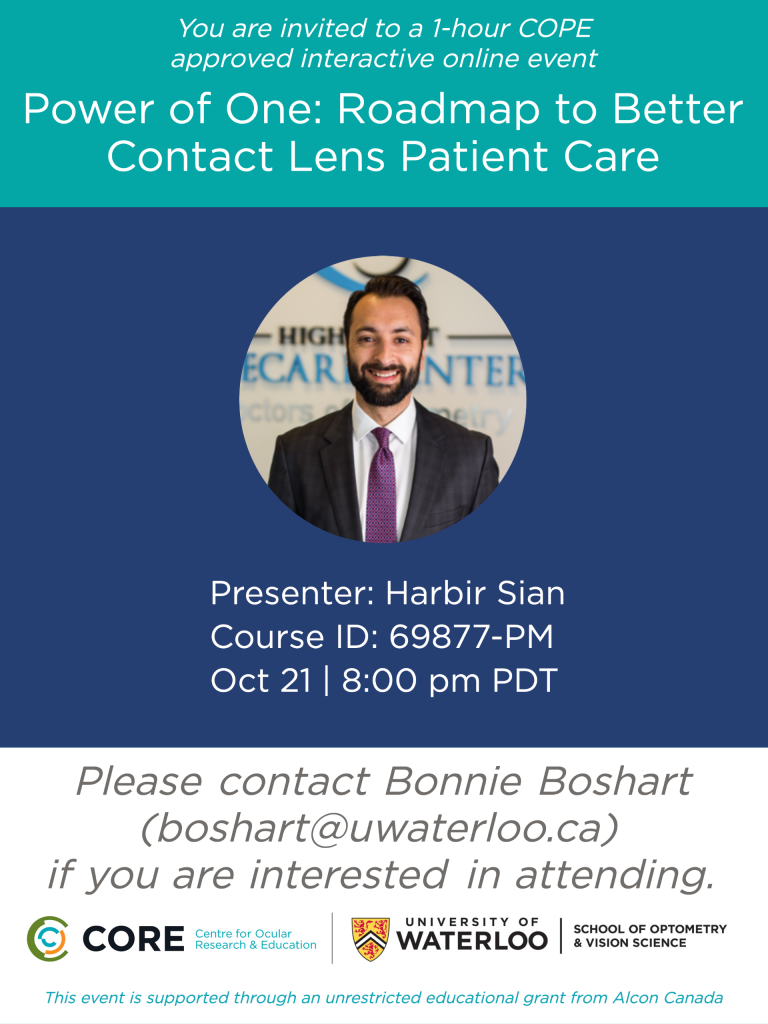WATERLOO, ONTARIO, October 13, 2025—The Centre for Ocular Research & Education (CORE) has published the latest edition of Contact Lens Update, dedicated to rapidly accelerating interest in pre-myopia that is influencing risk assessment, early intervention, and myopia management among clinicians. Guidance from four expert contributors includes strategies, technologies, and clinical insights for the pediatric and primary eye care communities. The bi-monthly resource is available at no charge by visiting ContactLensUpdate.com.
“Understanding and addressing pre-myopia has the potential to transform clinical practice, enabling eye care professionals to identify at-risk children earlier and better implement targeted interventions. With growing evidence and innovative management approaches, clinicians can now offer more personalized, proactive care that aims to reduce the burden of myopia later in life,” said Daddi Fadel, clinical scientist at CORE.
Amy Chow, a post-doctoral fellow at the University of Waterloo and the Centre for Eye and Vision Research (CEVR) in Hong Kong who specializes in pediatrics, binocular vision, and myopia management, wrote the issue’s opening editorial. She outlines key myopia risk factors such as low hyperopic reserve, rapid axial growth, limited outdoor time, intensive near work, and parental myopia. Her column also reviews predictive models and preventive measures, including more outdoor time, better near-work habits, low-dose atropine, myopia-control spectacles, and emerging red-light therapy.
Pauline Kang is an associate professor and deputy head of school at UNSW Sydney and leads the School of Optometry and Vision Science myopia clinic, where her research focuses on childhood myopia progression and myopia control. Her feature article highlights how early identification of pre-myopic children through cycloplegic refraction and risk-factor assessment allows preventive care. Repeated red-light therapy and low-dose atropine show the strongest evidence for slowing axial growth and delaying the onset of myopia, while increased outdoor time and education provide a modest, low-risk benefit. However, there remains ongoing debate concerning the safety of red-light therapy and concerns regarding rebound effects with atropine, that require careful consideration.
Wes McCann, an optometrist, lecturer, and consultant who owns 12 Canadian practices and is a Contact Lens Institute Culture Award honoree, shares the issue’s clinical insight. He presents two pediatric cases that demonstrate how axial-length tracking, lifestyle counseling, and timely use of low-dose atropine or myopia control lenses can delay myopia onset and slow progression. The article underscores the importance of early detection and ongoing monitoring of pre-myopia to help prevent high myopia and its associated ocular complications.
The conference highlight is presented by Zhuzhu Liu, an ophthalmologist and researcher at Tianjin Medical University Eye Hospital in China, who specializes in myopia control, orthokeratology, and pediatric eye health. In this randomized trial, repeated low-intensity red light slowed axial growth and refractive progression in Chinese children with pre-myopia, with early sub-foveal choroidal thickening mediating part of the effect and predicting 12-month myopia-control outcomes.
In addition to a complete archive of back issues, ContactLensUpdate.com offers a resource library that provides no-cost professional tools, patient resources, images and video. It also houses complimentary technical training videos produced by International Association of Contact Lens Educators, plus an industry glossary. Industry professionals can access the latest issue directly from ContactLensUpdate.com or quickly sign up for email receipt of future issues.
The publication receives support from the educational arms of Alcon, CooperVision, and Johnson & Johnson Vision.
# # #
About the Centre for Ocular Research & Education (CORE)
The Centre for Ocular Research & Education (CORE) was established in 1988 at the University of Waterloo’s School of Optometry & Vision Science. Over the next three decades, the organization evolved from a three-person operation into a thriving hub of basic and applied research, collaborating with sponsors, agencies and academia on advanced biosciences, clinical research and education. Its uncompromising independence and results of the highest quality have been at the heart of many of the most prominent advances in eye health. Today, its team serves a range of ophthalmic sectors, including medical devices, ocular pharmaceuticals, digital technology and others, with a focus on the anterior segment. For more information, please visit core.uwaterloo.ca.
MEDIA CONTACT
Lyndon Jones, Principal Scientist, CORE
+1.519.888.4065 or lwjones@uwaterloo.ca






